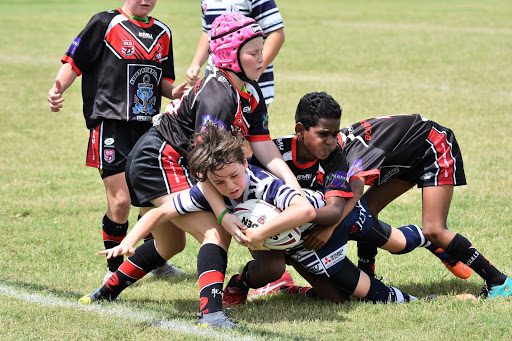Australia has footy fever. This fast, free-flowing ball game dates back to the 1850s and is now the most popular sport in Australia. Seemingly a hybrid of rugby and soccer, the game is formally known as Australian Rules Football has a measure of basketball, hockey, football, lacrosse, and volleyball as well.
People of all ages play footy. The standard game is played on an oval field as wide as an American football field and about twice as long. Two teams of 18 players compete to kick the ball between poles at each end of the field to earn their team point values that depend upon which two poles the ball passes.
Children in competitive sports
When children play footy, it is often a touch version, which reduces or eliminates injuries; perceived as safer. Despite this, the debate about whether or not children should play competitive sports rages on.
For many parents, safety is the primary concern. Still, they also have fears about the effect these types of sports have on their child’s development, whether pitting their child against others has value, and whether or not competitive sports will help their child achieve success as adults.
Studies fall on either side of the debate with statistics to support both views. It is not likely to be resolved any time soon. What can make a difference is how parents and their children approach competitive sports. It is also essential these evaluations occur on an individual basis because while many do, not all children thrive in such an environment.
When competition receives too much emphasis—win at all costs, always be the team’s star player, belittling the child over mistakes—any sport can become detrimental to a youngster. Conversely, approaching participation with the right attitude and great emphasis is on positive aspects, children can benefit.
Safety in sports
In the 29-team south metro junior football league, about half of the teams require helmets for children in younger age groups, despite the lack of helmet policy in AFL Victoria. When it comes to the topic of helmets, the league references a nine-year-old study conducted by experts in medical, brain, and safety science at three major Australian universities for their helmet policy. The study found little evidence to demonstrate protective headgear is effective at preventing injury for children playing footy.
Instead, the study suggests helmets may provide a false sense of security. If a player believes the headgear will protect him or her at all times, they may be more inclined to take actions associated with a higher risk of injury.
Who’s making the decision?
Though some leagues do not require helmets, teams must respond to parents’ worries—even though there is no tackling or bumping allowed in teams of young children. Though not required, age groups under 9s, under 10s, and under 11s have worn helmets for 10 years at the Ajax junior football club in Caulfield.
According to secretary Daniel Antman, the club takes a serious and conservative approach to safety in which education is critical. They brought in Gavin Davis, a Cabrini neurosurgeon, to train the club’s junior trainers on the topics of head injury and concussion.
Weighing the benefits
Though head injuries are serious considerations—not to mention broken bones, pulled muscles, and the like—parents and trainers weigh the benefits against the drawbacks each time a child takes the field.
According to statistics, 1 in 5 children and adolescents fall into the overweight or obese categories. For many children, participating in sports is effective at keeping them healthier. The aerobic activity can also increase cardiovascular fitness; promote the growth of bones, muscles, ligaments, and tendons; and improve a child’s coordination and balance. There are social benefits as well, such as greater confidence, improved social skills, and learning cooperation and leadership.
Parents opposed to competitive sports believe it is possible to achieve these benefits in other ways that are just as effective. Any type of activity can lessen the negative impact of a sedentary lifestyle and increase energy levels in young children—it’s not necessary to focus entirely or primarily on sporting activities.
Whether or not a child will partake in competitive sports is ultimately the decision of the parents. Those parents that take the time to educate themselves on the pros and cons will be in a better position to make the right decision for their child.



































